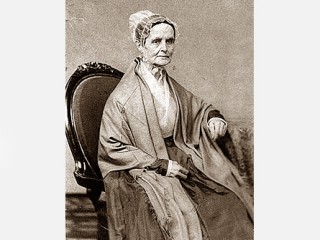
Lucretia Coffin biography
Date of birth : 1793-01-03
Date of death : 1880-11-11
Birthplace : Nantucket, Massachusetts, United States
Nationality : American
Category : Famous Figures
Last modified : 2010-07-15
Credited as : Pioneer , feminist leader, and social reformer
1 votes so far
Lucretia Coffin was born on Jan. 3, 1793, on the island of Nantucket, Mass. Her father was the master of a whaling ship and her mother a storekeeper. The family became Quakers and in 1804 moved to the mainland. Island women were self-reliant, and Quakers were distinguished for the high place they gave to women. Lucretia's independent views were therefore honestly come by. She was educated in Boston and New York. After working briefly as a schoolteacher, she married James Mott in 1811. He set up business with Lucretia's father in Philadelphia.
At the age of 28 Mott became a Quaker minister, and when the denomination divided over matters of doctrine she supported the liberal, or Hicksite, faction. The Motts were abolitionists, and their home became a station on the Underground Railroad, by which Southern slaves escaped to the North. Mott helped found the first antislavery society for women in 1837, and later, with other militant abolitionist women, helped William Lloyd Garrison take over the American Antislavery Society.
Although Mott was a radical abolitionist, she was not a typical agitator. At a time when the causes of woman's rights and abolition attracted vivid personalities, she was outstanding for her gentle manners and disarmingly soft ways. She was a beloved figure, especially because her sweet character was complemented by unswerving dedication to principle.
In 1840 Mott was one of a band of women who accompanied Garrison to London for a world antislavery convention. The orthodox Quakers and English abolitionists who dominated the meeting refused to seat them, fearing the convention would seem ridiculous if females participated. Garrison, who sat with the rejected women in the gallery, noted the contradiction in having a convention to abolish slavery "and at its threshold depriving half the world of their liberty." Like most of the American women, Mott found the experience wounding.
At the convention Mott met the young Elizabeth Cady Stanton, who attended it with her husband. Their friendship developed, although both were busy wives and mothers, and Mott was involved in promoting peace, temperance, and abolition along with woman's rights. Mott inspired her young protégé, who in time grew more radical than her mentor. This became apparent at the Woman's Rights Convention in Seneca Falls, N.Y., called by Stanton--the first such convention. Mott thought its resolution asking for woman's suffrage to be too far in advance of public opinion.
During the Civil War, Mott spoke on behalf of the 13th Amendment to the Constitution. She was deeply distressed by the split in the woman's-rights movement that developed in the late 1860s. She worked to heal it until her death on Nov. 11, 1880.
















